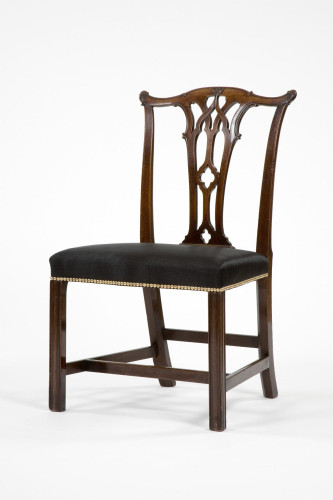30/2006-1
Collection
Furniture
Brief description
One of a set of four mahogany chairs in the style of Thomas Chippendale with a pierced gothic splat, a top-rail with carved foliate terminals and modern horsehair upholstery, probably made in England c.1765.
Object name
chair
Object number
30/2006-1
Location
On Display
Production date
c.1765 (manufactured)
Production place
England (manufactured)
Period
Georgian (1714-1837)
Material
mahogany
horsehair
calico
brass
walnut
oak
horsehair
calico
brass
walnut
oak
Technique
carved
joined
woven
stuffed
joined
woven
stuffed
Physical description
Mahogany chair with a pierced gothic splat, a top-rail with carved foliate terminals and a modern horsehair upholstered seat. The back rail is veneered with mahogany.
The chair has an even mahogany brown colour with heavier patination in the crevices of the carving, and the hollows of the mouldings etc. The patination on the legs is rather thicker than on the back, however the back surface is an even colour.
On the rear surfaces there is a suggestion that the timber was originally covered with a stained varnish. The back of the seat rail and the shoe (the raised pedestal which allows the splat to be fitted without impacting the upholstery/ seat rail) show signs of having been coloured. There is some worm damage to the left side of the back rail showing through the veneer. There are also traces of paper or cloth glued to the right hand underside of the back rail and the upper side of the back rail has new wood approximately half inch thick glued all along its length. The back rail also has a single line of old tack holes, approximately 2.5 cm apart and a central patched repair. The front and side rails appear to be original and the side rail appears to have significant worm to the right side. The front right corner brace has been replaced.
There is also wear to the front and back feet and the corners of the lower legs.
There are old nail holes and signs of worm damage visible on the underside of the drop-in seat frame. The frame appears to have been repaired at some time and the back part looks like a replacement. There is some wear around the feet. There is some small losses to the top of the back and the end of one small scroll is missing.
All the upholstery is modern and was done by Chapman’s London 2006.
The chair has an even mahogany brown colour with heavier patination in the crevices of the carving, and the hollows of the mouldings etc. The patination on the legs is rather thicker than on the back, however the back surface is an even colour.
On the rear surfaces there is a suggestion that the timber was originally covered with a stained varnish. The back of the seat rail and the shoe (the raised pedestal which allows the splat to be fitted without impacting the upholstery/ seat rail) show signs of having been coloured. There is some worm damage to the left side of the back rail showing through the veneer. There are also traces of paper or cloth glued to the right hand underside of the back rail and the upper side of the back rail has new wood approximately half inch thick glued all along its length. The back rail also has a single line of old tack holes, approximately 2.5 cm apart and a central patched repair. The front and side rails appear to be original and the side rail appears to have significant worm to the right side. The front right corner brace has been replaced.
There is also wear to the front and back feet and the corners of the lower legs.
There are old nail holes and signs of worm damage visible on the underside of the drop-in seat frame. The frame appears to have been repaired at some time and the back part looks like a replacement. There is some wear around the feet. There is some small losses to the top of the back and the end of one small scroll is missing.
All the upholstery is modern and was done by Chapman’s London 2006.
Dimensions
Height: 94.5cm
Width: 57cm
Depth: 48.3cm
Depth: 58cm
Width: 57cm
Depth: 48.3cm
Depth: 58cm
Website keywords
seating
Label
Label text for 1790 Period Room (Room 4), Geffrye Museum, 2010:
Chairs
The design of the chair backs is taken from the 1762 edition of the
pattern book by Thomas Chippendale, The Gentleman and Cabinet-Maker’s Director. The seats are covered with horsehair, which was commonly used for parlour chairs in middling homes towards the end of the eighteenth century. Unlike woollen fabric or silk, it could be easily wiped clean.
Mahogany, after 1762, replica upholstery in horsehair
Chairs
The design of the chair backs is taken from the 1762 edition of the
pattern book by Thomas Chippendale, The Gentleman and Cabinet-Maker’s Director. The seats are covered with horsehair, which was commonly used for parlour chairs in middling homes towards the end of the eighteenth century. Unlike woollen fabric or silk, it could be easily wiped clean.
Mahogany, after 1762, replica upholstery in horsehair




















